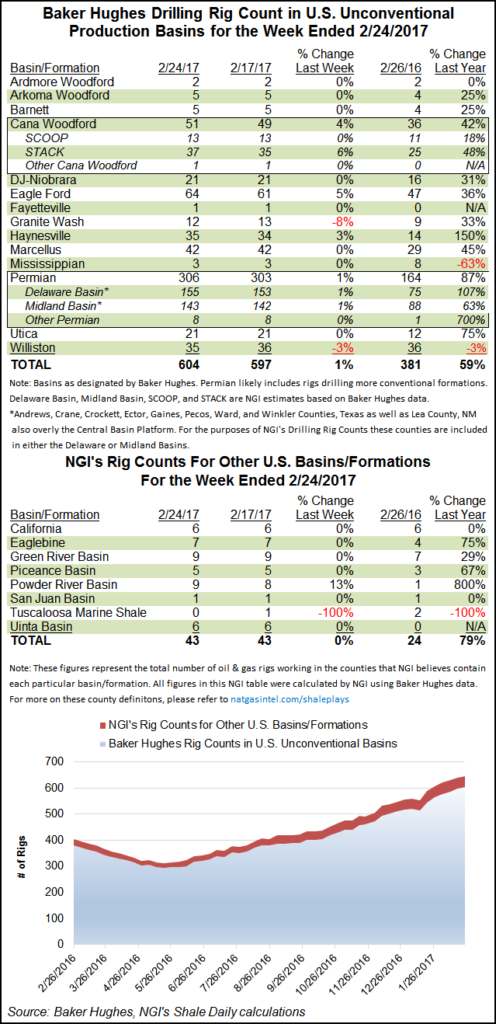Permian, Eagle Ford Add Three Rigs Each
Active U.S. land-based drilling rigs grew again in number, Baker Hughes Inc. said on Friday, but not by as much as in recent weeks.

Three U.S. land rigs were added to bring the total number of actives to 733 for the week ending Feb. 24. One rig rejoined the inland waters as one left the offshore. Five oil rigs came back, but two natural gas rigs left.
Ten horizontals returned, offset in part by the departure of three directionals and four verticals. At week’s end, the United States had 754 active rigs overall, up from 502 a year ago.
In Canada, 10 rigs came back to bring the active tally to 341. Twelve oil rigs came back as two natural gas rigs left service.
The overall North American count climbed by 13 to end at 1,095, up from 677 a year ago.
Texas was the big gainer again among states, adding eight rigs. The Permian Basin and Eagle Ford Shale each added three rigs.
Texas production for December as reported to the Railroad Commission of Texas (RRC) was 74.25 million bbl of crude oil and 566.77 Bcf of total gas from oil and gas wells. These preliminary figures will be updated as late and corrected production reports are received. Production reported to RRC for December 2015, was: 74.58 million bbl of crude oil, which was later updated to a current figure of 88.32 million bbl; and 625.41 Bcf of total gas, which was later updated to a current figure of 720.11 Bcf.
Texas preliminary December crude oil production averaged 2.4 million b/d compared to the 2.41 million b/d in December 2015. Texas preliminary December total gas production averaged 18.28 Bcf/d compared to the 20.17 Bcf/d of December 2015.
Texas production in December came from 169,564 oil wells and 92,685 gas wells.
From January 2016 to December 2016, total Texas reported production was 978 million bbl of crude oil and 8 Tcf of total gas. Crude oil production reported is limited to oil produced from oil leases and does not include condensate, which is reported separately.
The U.S. Energy Information Administration (EIA) said in a note Tuesday that U.S. crude oil production increased for the second consecutive month in November, the first time this has happened since early 2015, according to the agency. EIA said increased drilling in the Permian region and the start of a number of new projects in the Federal Offshore Gulf of Mexico (GOM) more than offset declining production from other regions in October and November.
“Increased drilling in the Permian region responded relatively quickly to a rise in the West Texas Intermediate (WTI) crude oil price, which increased from an average of near $30/bbl in the first quarter of 2016 to $45/bbl or higher beginning in the second quarter of 2016,” EIA said.
The Permian region was the only area covered in EIA’s Drilling Productivity Report that did not experience a month with a year-over-year production decline throughout 2014-2016, EIA said.
© 2024 Natural Gas Intelligence. All rights reserved.
ISSN © 2577-9877 | ISSN © 2158-8023 |
